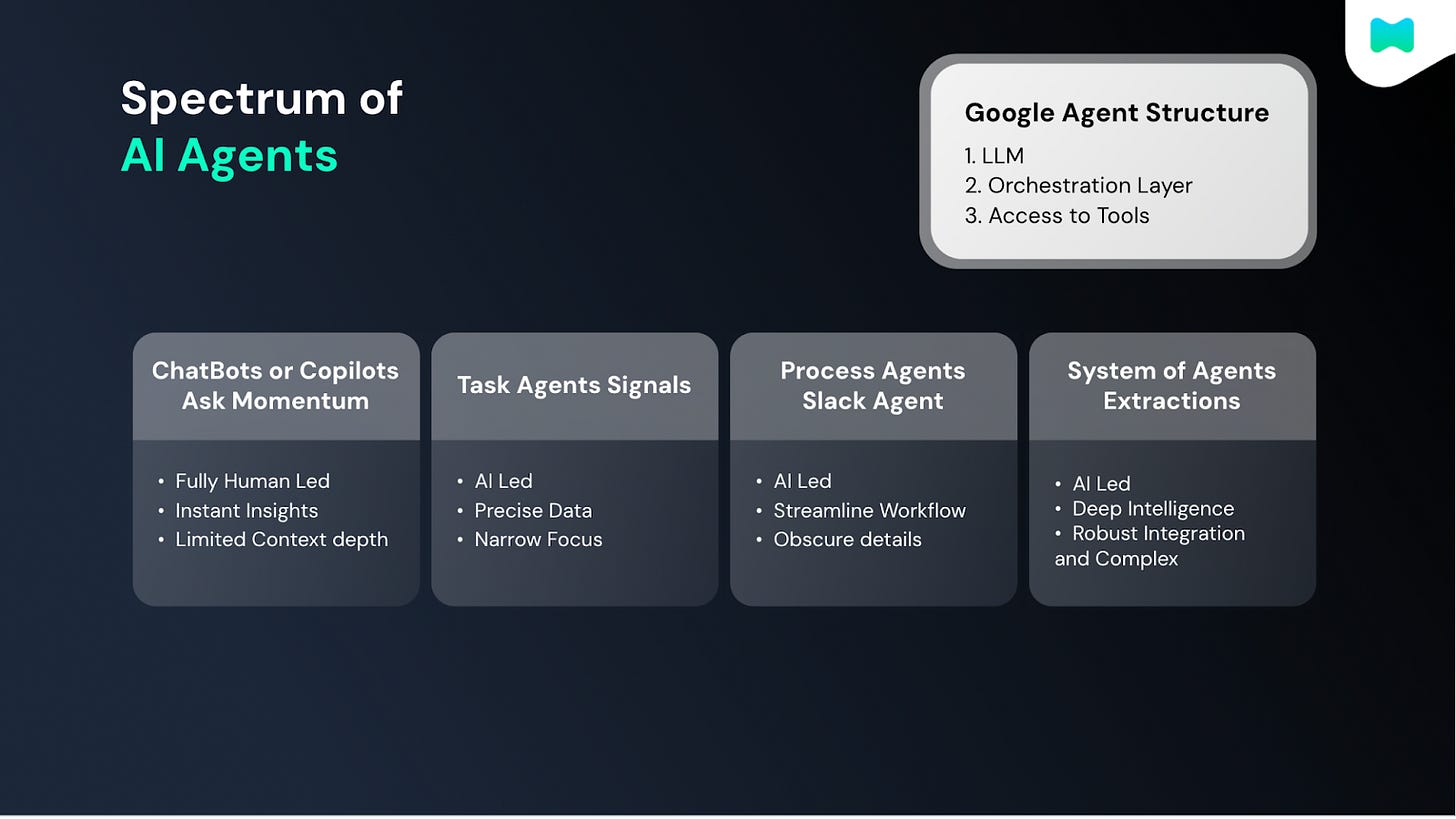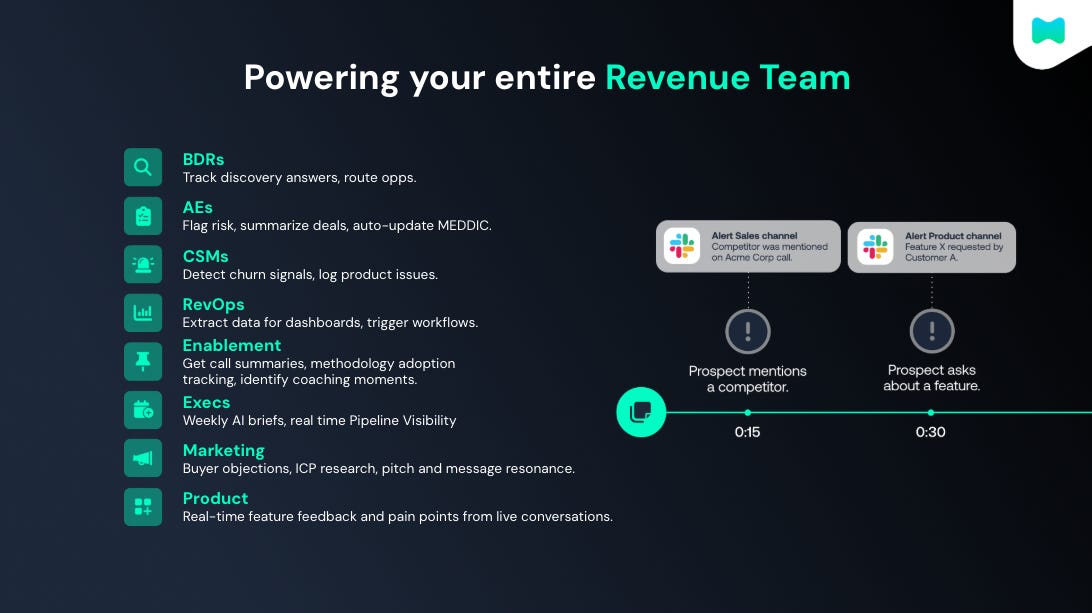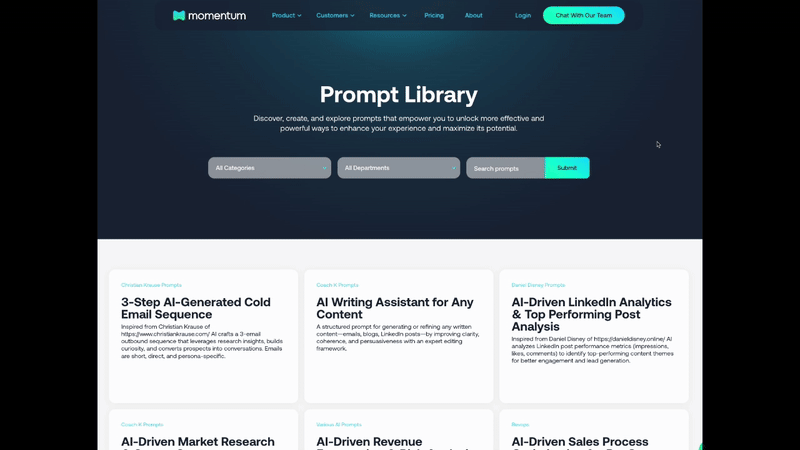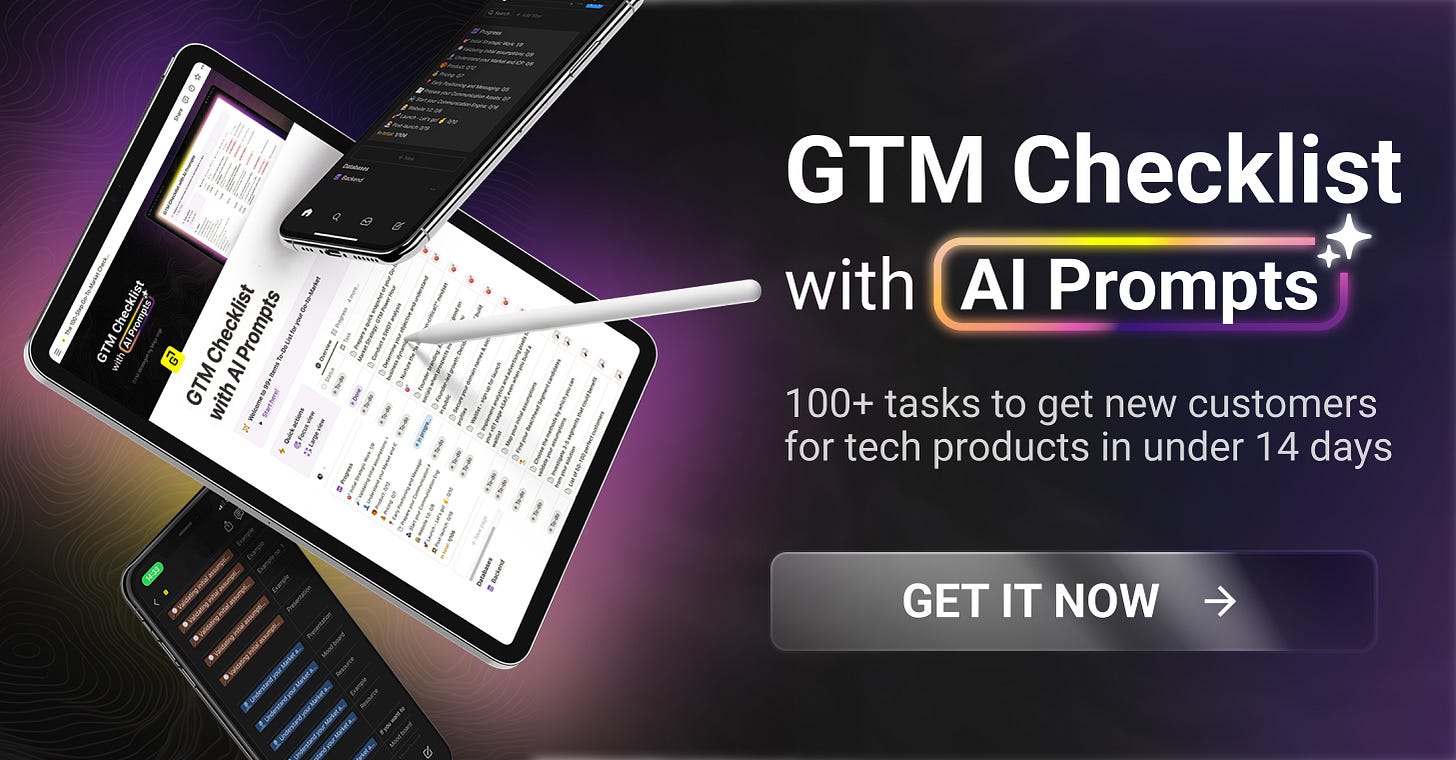The Hidden Execution Crisis: Why Humans as the Data Layer Is Breaking GTM
The most expensive part of GTM? Missing the data you already have
Jonathan Kvarfordt, Head of GTM Growth at Momentum.io, is one of my favorite people in the GTM AI space. We have done prompts together, he started the state of AI in GTM report and now he is on a mission to solve a human data entry problem - when he pointed out that sales reps capture <1% of what buyers say. A typical sales call has 8,000 words while a typical CRM note has 25 words. It became painfully evident that we are losing tons of intelligence in GTM.
Intelligence from customer calls has been pivotal for creating unique insights and personalised campaigns for my teams. We process customer calls transcripts for everything - sales decks, LinkedIn posts, personalization of outreach and offers - it is a treasury of insights. Jonathan will take us one step further - why even the conversation intelligence is not enough to create a true edge.
If you are at least semi-serious about RevOps and GTM automations, this one will be a treat for you, since it is very strategic and applicable for building GTM orgs. In case you are a solo player, feel free to skip to the 🎁 list of prompts or dive in anyway, because these issues will follow you down the line or may be relevant for your largest customers.
P.S.: All the visuals are from Momentum sales deck, if you need some inspiration.
The Quiet Collapse of Execution
Step into any pipeline meeting today, and you’ll see a symptom of the broader problem. The team joins, expecting to talk strategy. They’re ready to pressure test deal assumptions, identify risk, and share what’s working. Instead, the session turns into a live Salesforce data entry session. Everyone watches silently while a rep scrolls through stages, updates next steps, rewrites close dates, or tries to recall who the economic buyer was. The strategy conversation never really starts. You’ve already lost.
This is literally what my life as an enablement leader has been for years. Pipeline meetings have devolved into operations catch-up because the system still depends on humans to input the data, make it visible, and interpret what’s happening. That or I and Revops or Leadership become data police having to constantly bug the team who is trying to take care of customers to update their information for some leadership request. It’s friction and causes issues at the highest level of frustration for all parties and impacts business.
Why This Crisis Exists: Humans Are Still the System of Record
Most GTM teams today still run on a system where humans are expected to be the originators of structured information. Sales reps are tasked with logging data that CRMs rely on. Managers interpret and repackage that information for leadership. Enablement tries to measure what’s happening in the field based on scattered recaps or one-off anecdotal feedback.
Everything hinges on whether a human remembers, records, or reports what happened. That assumption worked when GTM motions were smaller, cycles were slower, and buyers were more predictable. It doesn’t hold up in today’s environment—where speed, visibility, and adaptability are essential.
If your entire revenue operation depends on someone remembering to log the next steps, tag the decision maker, or flag a competitive risk, then your execution system is built on sand.
Execution Isn’t a Workflow Problem—It’s a Data Infrastructure Problem
Let’s clarify something. Most revenue leaders think their team has a workflow or process issue. That’s rarely the root cause. What they actually have is a structural data architecture issue.
The workflows break down because the systems aren’t instrumented to run automatically. They’re triggered by memory, by verbal check-ins, by post-call debriefs. So every automation or enablement effort ends up being reactive—responding to manually surfaced information instead of structured inputs that flow automatically from customer interactions.
Teams don’t struggle because they lack hustle. They struggle because their execution engine was never designed to produce consistent, structured signal without human intervention.
The implications are severe:
Forecasts are unreliable because deal stages and close dates are out of sync.
Coaching is misaligned because there’s no baseline view of how reps are actually running calls.
Playbook adoption is unclear because there’s no instrumentation to track usage.
AI tools underperform because they’re being applied to inconsistent or incomplete inputs.
Conversation Intelligence Isn’t Enough
A lot of companies think they solved this problem when they bought a conversation intelligence platform. They didn’t. Recording a call and transcribing it is not the same thing as structuring the data inside of it.
Transcripts are raw material. Insight comes only when that raw material is parsed, labeled, and connected to the systems that matter—like Salesforce, Slack, or your enablement platform.
Without that connective tissue, conversation intelligence becomes another silo. It’s useful for reviewing calls and running coaching sessions, but it doesn’t power your system. It doesn’t trigger workflows. It doesn’t replace the need for a rep to type something into a CRM. It just gives you another place to go look for answers.
That’s why AI adoption doesn’t always move the needle. AI agents built on messy or incomplete data are just faster ways to produce bad outputs. The model isn’t the problem. The structure of your execution system is.
The False Promise of AI Without Structured Signal
This is where most companies get it wrong. They want automation. They want agents. They want predictive insight. But they’re trying to build that on top of human-entered notes and flat transcripts.
It doesn’t work.
You can’t automate what isn’t reliably captured. You can’t predict what isn’t consistently tracked. You can’t personalize what isn’t structured. If the system doesn’t produce clean signal from real buyer interactions, your AI initiatives will be performative at best and damaging at worst.
There’s a rush right now to adopt generative AI across the GTM stack. But what people are missing is that AI without structured data is noise. A thousand agents can’t help you if they’re operating off incomplete or misaligned inputs.
So the priority for revenue teams right now isn’t more tools. It’s better data architecture. You have to fix what your system is observing and how it captures that information before anything else will make a difference.
The Real Shift: Stop Treating Humans as the Data Layer
The core mental model that needs to shift is this: humans should not be the system of record nor should they be the data entry into a system of record. Their role is not to be the capture layer. Their role is to show excellence and build relationships with customers and prospects. The system’s job is to observe, tag, store, and act on the data.
Right now, most companies have that reversed. Reps are being asked to log call summaries, next steps, objections, competitor mentions, and more. Managers are expected to synthesize this into dashboards or updates. RevOps teams spend hours cleaning and correcting records just to build an accurate report. It’s no wonder strategic conversations get sidelined. Everyone is too busy keeping the system alive.
A modern GTM system must operate differently. Calls, emails, and customer interactions should automatically produce structured data that feeds into execution. Managers shouldn’t ask for updates. They should see them. Enablement shouldn’t guess at adoption. They should measure it. Leadership shouldn’t wait for QBRs. They should spot trends in real time.
This doesn’t mean removing humans. It means designing systems that support them with better signal, clearer insight, and less friction.
What This Looks Like in Practice
You don’t need to boil the ocean to start. But you do need to stop pretending that manual input is a viable strategy.
Start by auditing your key workflows. Identify where human action is the trigger for execution. That includes logging deal risk, updating fields, handing off to CS, or flagging competitor mentions. Ask yourself—what would need to be true for those workflows to run without asking someone to type anything in?
From there, shift your attention to the conversations your team is already having. These are your most valuable data assets. They contain the raw signal for everything: buyer pain, decision criteria, stakeholder dynamics, objections, urgency, and intent. The question is whether you can extract that information cleanly, consistently, and automatically.
You need a way to move from transcript to structured signal. That means detecting the right patterns, mapping them to CRM fields, and linking them to workflows. Whether you build this internally, stitch together tools, or use a platform like Momentum.io, the outcome is the same: execution becomes automatic because data becomes structured.
Here’s what starts working when you get this right:
Sales stages become accurate because they reflect actual buyer behavior, not guesses.
Coaching becomes relevant because it’s tied to what reps are actually doing, not what they say they’re doing.
Playbook adoption becomes measurable because every call is instrumented.
Forecasting becomes trustworthy because deal health is based on conversation signals, not just rep confidence.
Automation becomes valuable because it’s driven by real buyer data, not artificial triggers.
This is what an execution-ready GTM system looks like. It’s not built on effort. It’s built on structure.
How Momentum Solves It: Rebuilding Execution Around Signal, Communication, and Automation
Momentum was built to solve this problem at the root. Most platforms offer surface-level insights or dashboards. Momentum replaces the brittle, human-dependent execution layer with an AI-powered GTM system that runs on clean signal and structured action. It does this through three foundational pillars.
First, Momentum acts as a first-party data provider, turning unstructured calls, emails, and buyer interactions into structured, clean data. This isn’t transcription or summary. It’s precise signal capture—mapped directly to your CRM fields and GTM metrics. Every objection, stakeholder role, pricing discussion, or competitor mention is tagged, structured, and stored. No more relying on reps to fill in deal details after the fact.
Second, it delivers communication of the right signal, to the right person, at the right time—without bias. Reps, managers, and leaders each get surfaced what matters to them, when it matters, without waiting for manual rollups or subjective interpretation. Managers get alerted to real risk. CS gets notified when a deal is ready to hand off. Leadership sees strategic patterns emerging from real buyer behavior. Everyone gets aligned around objective, real-time truth.
Third, Momentum powers automation and orchestration, taking those structured signals and turning them into execution. Coaching workflows, CRM updates, Slack alerts, CS handoffs, and even internal deal reviews are triggered automatically—reducing time-to-action and keeping deals moving forward. There’s no need to wait for meetings or reminders. The system moves with your buyer.
Together, these three pillars—clean structured data, intelligent communication, and automated execution—transform Momentum from just another AI tool into the operating system for modern revenue teams. The result is execution that doesn’t depend on memory, doesn’t rely on meetings, and doesn’t break under pressure.
More than just Prompting with ChatGPT
Most AI tools today offer little more than basic summarization. They run a single-pass LLM over a raw transcript, without speaker attribution, CRM awareness, or structured integration. The result? Flat output with no context, no traceability, and no real impact on execution. Momentum is fundamentally different. It acts as a GTM data refinery, transforming raw conversations into structured, validated, and CRM-ready intelligence. Using a multi-layered architecture—from input normalization and custom context engines to speaker attribution, semantic extraction, and structured output—Momentum doesn’t just summarize; it powers execution at scale. It extracts signal, applies context, and feeds accurate data back into your systems—so your GTM motion runs on precision, not guesswork.
The Cultural Shift: From Reporting to Orchestration
Fixing execution isn’t just about data. It’s also about culture.
Right now, most GTM teams operate in a reporting culture. Reps report what happened. Managers report what’s going on. Leaders report what they think is next. Everyone’s translating, summarizing, or guessing.
That model slows everything down. It introduces noise and bias. It creates room for misalignment to fester. And it guarantees that your strategy will always lag reality.
The future is orchestration. In an orchestrated system, the data flows from the point of contact with the customer into the systems that drive execution—without needing manual translation. Your workflows don’t depend on meetings. Your insights don’t depend on memory. Your strategy is informed by reality, not anecdote.
This is a fundamental shift in how revenue teams operate. And it’s the shift that separates top-performing orgs from everyone else.
Final Thought: Precision Execution Starts With the Right Foundation
AI is not the answer unless you fix the architecture it sits on. Your CRM is not your source of truth if it requires constant human correction. Your enablement program can’t scale if it’s built on assumptions. Your forecast won’t work if it’s powered by stale summaries and guesswork.
Execution isn’t a department. It’s not a tool. It’s not a dashboard. It’s a system.
And that system either runs on clean, structured data—or it doesn’t run at all.
Don’t let the execution crisis stay invisible.
See how high-growth teams like 1Password, Ramp, Alation, Zscaler, Windsurf, Cherry, and more are using Momentum to turn raw conversations into structured, revenue-driving action.
Do you want free AI prompts to help you with ABM, sales, and all other go-to-market motions? Momentum launched a MEGA prompt library with 200+ AI prompts by senior GTM experts Nick Bennett, Jonathan Kvarfordt, Daniel Disney, Christian Krause - and also some of my prompts. Grab it now!
📘 New to GTM? Learn fundamentals. Get my best-selling GTM Strategist book that helped 9,500+ companies to go to market with confidence - frameworks and online course included.
✅ Need ready-to-use GTM assets and AI prompts? Get the 100-Step GTM Checklist with proven website templates, sales decks, landing pages, outbound sequences, LinkedIn post frameworks, email sequences, and 20+ workshops you can immediately run with your team.
🏅 Are you in charge of GTM and responsible for leading others? Grab the GTM Masterclass (6 hours of training, end-to-end GTM explained on examples, guided workshops) to get your team up and running in no time.
🤝 Want to work together? ⏩ Check out the options and let me know how we can join forces.















Yep. Been there.
- Our CRM’s most consistent data field is “Last Updated: Never.”
- Forecasting winds up being more tarot than Tableau.
- “Next steps” = “vibes-based intent signal”
- Sales swears they tagged the buyer. Turns out it was the office dog. Again.
Humans weren’t meant to be the ETL layer.
Super interesting. How can I learn a ton more about your offerings before talking with sales?